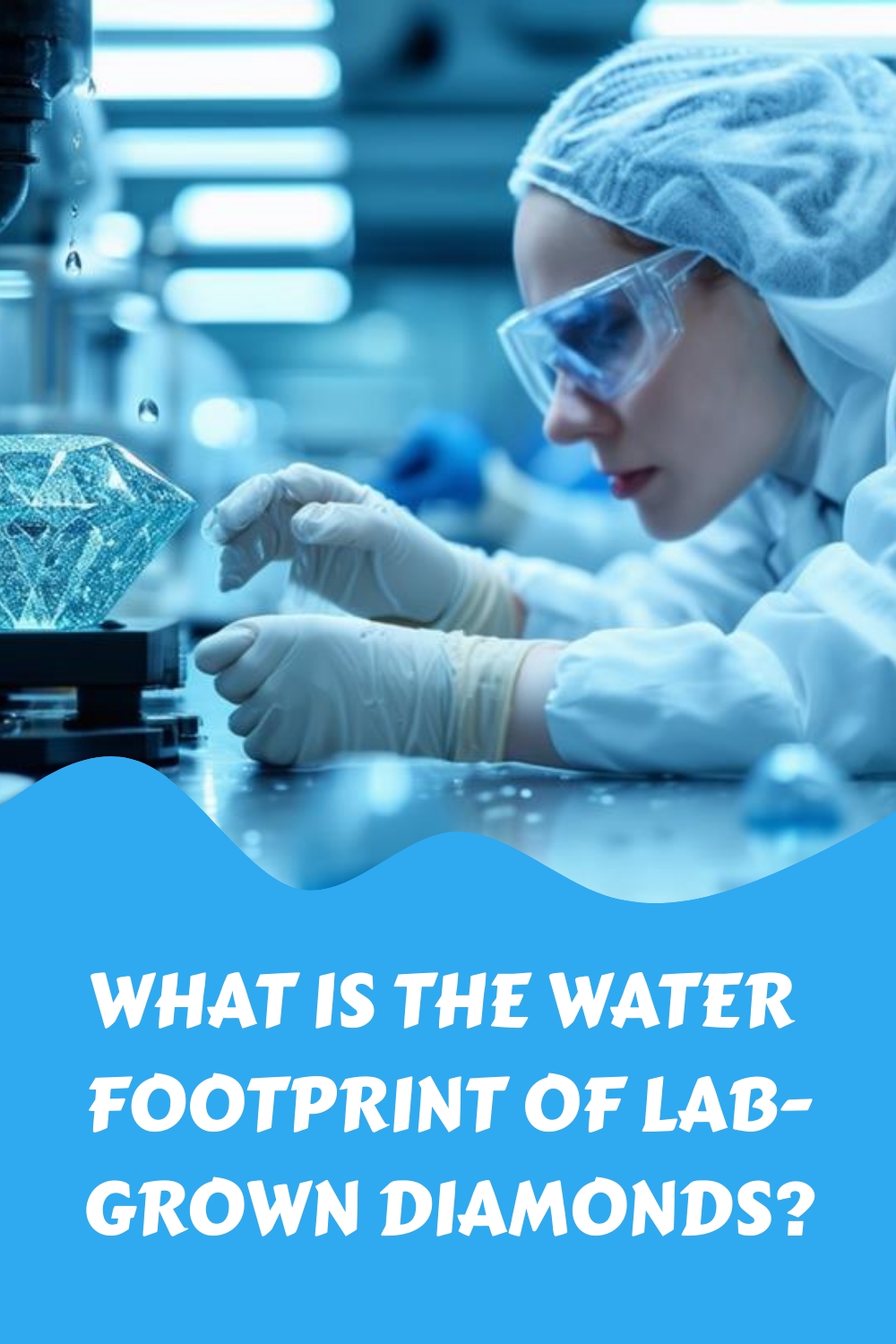Article Contents
Lab-grown diamonds significantly reduce water usage compared to traditional mining. These diamonds need about 18 gallons of water per carat, markedly less than the 126 gallons required for mined diamonds. Techniques like High Pressure High Temperature (HPHT) and Microwave Plasma Chemical Vapor Deposition (MPCVD) enhance this efficiency.
Choosing lab-grown diamonds supports water conservation and aligns with the growing consumer demand for sustainable products, reflecting both an aesthetic choice and environmental responsibility. This shift towards sustainable luxury encourages further exploration into environmentally friendly practices within the jewellery industry.
Key points
- Lab-grown diamonds utilise approximately 18 gallons of water per carat, a significantly lower amount compared to mined diamonds, thus enhancing sustainability.
- Techniques such as High Pressure High Temperature (HPHT) and Chemical Vapor Deposition (CVD) are employed in the production of lab-grown diamonds to minimise water consumption.
- This decrease in water usage contributes to environmental responsibility within the luxury goods sector.
- Opting for lab-grown diamonds aids in the conservation of water and other natural resources, supporting ecological sustainability.
Water Usage in Laboratory-Grown Diamonds
The minimal water usage of lab-grown diamonds, particularly through the High Pressure High Temperature (HPHT) method, highlights a significant environmental benefit compared to traditional mining. HPHT, pivotal in synthetic diamond production, primarily utilises water to cool the machinery, thereby reducing the environmental footprint. This efficient use of resources is crucial in a market increasingly focused on sustainability.
By adopting such technology-driven production methods, the diamond industry can substantially lower its water footprint. This shift not only conserves water resources but also meets consumer demand for eco-friendly products. It allows consumers to choose diamonds that reflect their values of conservation and responsible consumption.
The adoption of water-efficient technologies in the production of lab-grown diamonds sets a new standard in the luxury market, merging elegance with environmental responsibility. This shift is essential, promoting sustainability while appealing to the environmentally conscious consumer.
Comparing Water Footprints
When assessing water footprints, it's clear that lab-grown diamonds utilise significantly less water than mined diamonds, consuming only about 0.003 cubic meters of water per carat, compared to approximately 0.1 cubic meters for traditional mining. This disparity highlights the efficiency of lab-grown diamond production methods, such as MPCVD, which are less water-intensive and thus more sustainable.
Traditional diamond mining, on the other hand, is a resource-intensive process that places considerable strain on environmental resources. Choosing lab-grown diamonds supports more sustainable jewellery industry practices, aligning with the preferences of consumers who are increasingly conscious of environmental impacts.
The process of creating diamonds in controlled environments not only reduces water usage but also minimises the ecological footprint of diamond production. Consumers who opt for lab-grown diamonds contribute to industries that prioritise technological advancement, conservation, and responsible resource management. This choice supports a shift towards more sustainable practices and encourages a responsible relationship with our planet.
Production Techniques and Water
Investigating the production techniques of lab-grown diamonds, such as High Pressure High Temperature (HPHT) and Microwave Plasma Chemical Vapor Deposition (M-CVD), highlights their differing water usage and environmental impacts. HPHT consumes considerably less water compared to M-CVD.
This difference emphasises the necessity to choose and optimise methods that minimise water consumption, thereby enhancing the sustainability of these environmentally friendly diamonds.
Reduction in Water Usage
Advanced production methods such as HPHT (High Pressure High Temperature) and CVD (Chemical Vapor Deposition) significantly reduce water consumption in the manufacturing of lab-grown diamonds. These techniques demonstrate the successful integration of sustainable practices within the luxury goods industry. In contrast to conventional diamond mining, which requires substantial amounts of water, lab-grown diamonds are produced with considerably less water. This approach not only conserves vital natural resources but also promotes ecological sustainability.
| Aspect | Benefit |
|---|---|
| Water Usage | Significantly reduced |
| Environmental Impact | Substantially minimised |
| Sustainability | Greatly enhanced |
| Resource Management | Effectively optimised |
Adopting these technologies leads to a reduction in environmental harm, ensuring that luxury production can coexist with environmentally responsible practices.
Recycling Process Impact
The recycling process in synthetic diamond manufacturing significantly reduces water consumption and supports sustainable practices. By reusing reclaimed diamonds and diamond materials, the industry decreases its reliance on new raw materials and conserves water resources.
This method adheres to the principles of a circular economy, promoting the reuse and recycling of resources, which leads to more sustainable sourcing methods. Consequently, the environmental impact, especially regarding water use, is substantially reduced.
Employing recycled materials, synthetic diamond manufacturers demonstrate their commitment to eco-friendly production and natural resource conservation, aligning with the goal of merging luxury with environmental responsibility.
Environmental Advantages of Lab-Grown Diamonds
Lab-grown diamonds offer a significant environmental benefit due to their minimal water usage compared to mined diamonds. This efficient use of resources not only promotes sustainable practices but also highlights the environmental advantages of synthetic diamond production.
Below are essential points illustrating why lab-grown diamonds are a more sustainable choice:
- Reduced Water Use: Lab-grown diamonds require significantly less water than traditional diamond mining, reducing their environmental footprint.
- Sustainable Production: The manufacturing process for lab-grown diamonds is designed to use minimal water, enhancing the sustainability of the diamond industry.
- Conservation of Natural Resources: The low water requirement for producing lab-grown diamonds aids in the preservation of vital water resources, crucial for ecological health.
- Eco-Friendly Reputation: The small water footprint associated with lab-grown diamonds bolsters their status as an environmentally responsible option, attracting eco-conscious consumers.
Opting for lab-grown diamonds supports environmentally responsible consumption and contributes to the goals of resource conservation and environmental protection.
Impact on Global Water Resources

Lab-grown diamonds significantly alleviate the pressure on global water resources compared to traditional mining, which uses about 0.1 cubic meters of water per carat. In contrast, the production of lab-grown diamonds requires substantially less water, contributing to a minimal water footprint. This difference underscores the role of technological advancements in enhancing sustainability.
These diamonds are produced through precise and controlled methods that prioritise minimal use of natural resources, setting a new benchmark for environmental responsibility. The process not only conserves water but also supports broader ecological and resource preservation efforts, making it a prime example of sustainable sourcing.
Consumer Choices and Water Conservation
Opting for lab-grown diamonds contributes significantly to water conservation efforts within the jewellery industry. As awareness increases, consumers are becoming more aware of the environmental benefits offered by these alternatives. Choosing lab-grown diamonds not only demonstrates a commitment to environmental preservation but also enables consumers to actively support sustainability practices. Here are the specific advantages of selecting lab-grown diamonds:
- Reduced Water Consumption: Lab-grown diamonds require only 0.003 cubic metres of water per carat, dramatically less than the 0.1 cubic metres used for each carat of mined diamonds.
- Endorsement of Advanced Techniques: Selecting lab-grown diamonds supports the use of innovative manufacturing technologies that have a lower environmental footprint.
- Encouragement of Sustainable Practices: Purchasing lab-grown diamonds boosts the market demand for eco-friendly products, prompting more businesses to adopt sustainable manufacturing processes.
- Awareness and Education: Choosing lab-grown diamonds increases consumer knowledge about the environmental impact of their purchases and encourages others to consider sustainable options.
Choosing lab-grown diamonds represents not just a style choice, but a conscious decision to support environmentally sustainable practices that align with the preservation of natural resources. This choice supports a vision of a future where aesthetic appeal and environmental responsibility are seamlessly integrated.
Frequently Asked Questions
How harmful are lab-grown diamonds for the environment?
Lab-grown diamonds generally have a lower environmental impact than mined diamonds, using less energy and creating more manageable waste. This method aids in preserving natural resources and promoting environmental sustainability.
What is the carbon footprint of a synthetic diamond?
The carbon footprint of a lab-grown diamond is much lower compared to that of natural diamonds, mainly because of lower energy usage and fewer production emissions. In particular, lab-grown diamonds only produce 0.028 grams of carbon per carat.
Can lab-grown diamonds be submerged in water?
Yes, lab-grown diamonds are safe to expose to water. They have the same chemical and physical properties as natural diamonds, including durability, which means they can be exposed to water during activities such as swimming or cleaning.
How much water does diamond mining use?
Diamond mining typically requires around 0.1 cubic metres of water for every carat produced. It is essential to introduce efficient water management policies and practices at mining locations to minimise environmental effects and maintain operations in a responsible manner.
Conclusion
Lab-grown diamonds significantly reduce water usage compared to traditionally mined diamonds, reflecting an advancement in eco-friendly production technologies. This sustainable approach supports global water conservation efforts, making lab-grown diamonds an environmentally responsible choice for consumers.
By opting for lab-grown diamonds, individuals align themselves with sustainable practices, embracing both luxury and environmental stewardship. This choice is crucial as it supports the preservation of diminishing water resources, marking a shift towards sustainable luxury in the jewellery industry.



